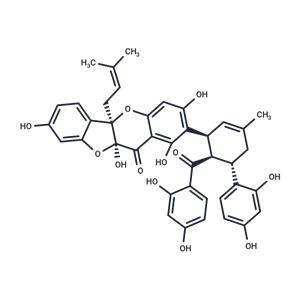| 名称 | Sanggenon C |
| 描述 | Sanggenon C is a flavanone Diels-Alder adduct compound isolated from the root bark of Morus alba. Sanggenon C can inhibit NF-κB activity, inhibit the expression of inducible nitric oxide synthase in RAW264.7 cells, and inhibit tumor necrosis factor-α-stimulated cell adhesion and vascular cell adhesion molecule-1 expression; Sanggenon C also has antioxidant and anti-inflammatory effects, and also has the effect of inhibiting pancreatic lipase. [1,2] |
| 体外活性 | METHODS: Appropriate concentrations of Sanggenon C (10 and 20 μM) were administered to U-87MG and LN-229, as well as dimethyl sulfoxide (DMSO) as a control, for 48 hours. Cell viability was determined by MTT assay.
RESULTS Sanggenon C inhibited the cell proliferation of GBM cell lines U-87 MG and LN-229 in a concentration-dependent manner.[1]
METHODS: U-87 MG and LN-229 cells were treated with Sanggenon C (10 μM), cell apoptosis was detected by flow cytometry, and the expression levels of related proteins were analyzed by Western blot.
RESULTS Silencing of DAPK1 reduced Sanggenon C-induced cell apoptosis. Western blot analysis further showed that in GBM cells treated with Sanggenon C, the protein levels of C-PARP and C-Caspase3 were reduced by silencing DAPK1. [1]
METHODS: Human colon cancer cell line (HT-29) was treated with Sanggenon C (0, 5, 10, 20, 40 and 80 μM) for 0, 12, 24, 48 or 72 h. As a measure of intracellular ROS and ATP, the production of NO in cells was measured by the Griess method according to the instructions of the NO detection kit.
RESULTS Sanggenon C can increase the level of intracellular ROS in human colon cancer cells, and this accumulation is enhanced when the dose is increased; Sanggenon C can interfere with the level of intracellular ROS; Sanggenon C can interfere with and increase the levels of intracellular Ca2+ and ATP, both in a time-dependent manner, and this accumulation is enhanced when the dose is increased; Sanggenon C can significantly interfere with and inhibit the production of NO in a dose- and time-dependent manner. [2] |
| 体内活性 | METHODS: Mice were intraperitoneally injected with Sanggennaon C (10 mg, 20 mg/kg/day) for 3 weeks. Four weeks after surgery, the hearts, lungs, and tibiae of the mice were dissected and weighed or measured, and the heart weight (HW)/body weight (BW) (mg/g), HW/tibia length (TL) (mg/mm), and lung weight (LW)/BW (mg/g) ratios were compared among the different groups.
RESULTS Sanggennaon C treatment prevented the development of ventricular dysfunction, such as decreased left ventricular end-diastolic diameter, left ventricular end-systolic diameter, and increased LVFS and LVEF; Sanggennaon C-treated mice showed attenuated cardiac hypertrophy, such as decreased CSA, and reduced HW/BW and HW/TL ratios. [2] |
| 存储条件 | store at low temperature | Powder: -20°C for 3 years | In solvent: -80°C for 1 year | Shipping with blue ice. |
| 溶解度 | DMSO : 7.09 mg/mL (10 mM), Sonication is recommended.
|
| 关键字 | Inhibitor | Nuclear factor-kappaB | Sanggenon C | NF-κB | Nuclear factor-κB | inhibit |
| 相关产品 | Sodium Houttuyfonate | Zingerone | Lidocaine | α-Lipoic Acid | Diethylmaleate | Glucosamine | sodium lauroyl-α-hydroxyethyl sulfonate | Lidocaine hydrochloride | 5-Aminosalicylic Acid | Indole-3-carbinol | Diallyl disulfide | Sodium salicylate |
| 相关库 | 经典已知活性库 | 天然产物库 | 高通量筛选天然产物库 | 抗衰老化合物库 | 已知活性化合物库 | 古代经典名方目录分子库 | 抗癌活性化合物库 |

 United States
United States



